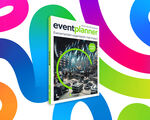There's nothing worse for an attendee than staring at a huge and complicated event registration form and not know where to start. An online registration form that you, as an event manager, approved for publishing.
You are about to lose that potential attendee. You'll be lucky if you don't. And if the attendee will have the courage to fill out the form and register, you'll more than likely incur a big headache while trying to process the information he or she submitted.
Why? Bad online registration forms can ruin your event for numerous reasons. But first, let’s check out what a bad registration form looks like:
- It's too long and time consuming
Who wants to spend their precious time on filling out an exhausting event registration form? As Julia Rutherford Silver notes in her book Professional event coordination, "Registration forms, either physical or digital, must be quick and easy to fill out."
- The structure of the form is not user friendly
When the sequence of the information on the form is not clear, people can feel confused. For example, you can’t mix the travel and accommodation details with questions about the professional activity.
- The system doesn’t recognize the user who wants to register.
Let's say that you sent an invitation email to a potential attendee with a link to a registration form. If the attendee decides to register by clicking directly on the link provided in the email, it will be irritating if the registration software won't recognize the user who wants to attend, and he or she needs to fill in the basic information (for example his name and email) you already have (you used it to sent and address the invitation).
- The required information is not relevant for the event.
A bad registration form includes irrelevant data fields. For example, it's absurd to ask the attendees to fill out the information about any dietary restrictions or preferences if the event will last a few hours and there will be only a coffee break.
- The requested information is not enough to manage the logistics of the event.
One of the main reasons why event managers need a registration form is to gather important data about their attendees. If planners miss the chance to ask for relevant data (for example, 'Indicate if you are attending the dinner'), they will encounter difficulties when dealing with the event logistics.
- The questions are hard to understand.
Poorly worded or confusing questions may create misunderstandings. If you meant one thing, but the attendee understood another thing, expect problems.
- The payment options are not linked to the registration form.
There are cases when attendees have to make the payment first, then complete the registration form and attach the confirmation paper of the payment receipt. This method makes the registration process slow and unfriendly.
If you expected creating an online registration form to be a breeze, you were wrong. As you can see, there are multiple factors to take into account. Yet, running a successful event depends on the skillful design of the registration form. Otherwise, it can ruin your event.
How a bad registration form can sabotage your event
- It puts off potential attendees
Put yourself in the shoes of a customer making an online purchase. You’re not 100% sure you want the product, but you say to yourself, "Sure, I'll buy it. Why not?" So you add the product to your online basket and check out. But when you land on the purchasing page, you see that you have to fill out a lot of data fields and enter again your banking data. You didn't even really want the product in the first place, so why bother? You close the window and forget about it. The same thing happens to potential attendees that aren’t 100% sure they even need to attend your event. The more simplistic your form is, the more likely they are to fill it out and click 'Attend'.
- It creates a bad first impression.
The registration form is one of the first contacts potential attendees have with you and your event. According to the event expert Julia Rutherford Silver, "How the registration process is managed - either prior to the event or on-site - gives a lasting first impression of the event, the event organization, and how the attendee can expect to be treated throughout the event experience." If your registration form is not user-friendly or is too long, messy, or confusing, potential attendees will form a negative first impression about the event. Are you sure you want that to happen?
- It provides the wrong (or incomplete) information.
This part refers to your work as an event manager. It solely depends on you if you want to have stress-free days or not. Apart from registering and keeping account of the attendee count, the registration form is a perfect way to ask for information that will impact your event’s logistics. If you don’t ask the right questions or forget to include pertinent fields (such as, “Are you traveling with a personal care attendant?”), you’ll miss important data and you won’t be able to deal with special accommodation requests.
So what you should do to avoid this? Here's a list of steps to take into account when creating a great registration form.
Step 1: Identify all the data you need from the attendees
There are two types of information you need to collect from attendees: their basic information (name, address, phone, special needs, etc.) and additional information, which depends on the type of the event (attendance confirmation for specific seminars or workshops, education level, travel and accommodation preferences, etc.).
Review your event and identify data points your attendees will need to provide in order to ensure your event logistics are executed flawlessly. For example, you have to know how many people will be attending a lunch or cocktail dinner (and also if they have any dietary requirements).
Likewise, you'll need to know if people with special needs will be attending your event. Otherwise, you'll be unable to accommodate the venue for their requirements. Also, don’t forget that you can choose whether or not some to make certain information fields mandatory for registration.
Step 2: Formulate the questions correctly
Another important feature of creating a quality registration form is the way you articulate the questions. This way, you'll avoid any confusion and misunderstanding. Of course, there are some standard fields such as 'name', 'email', 'age', ... yet to gather other data points, you’ll have to develop good questions.
Take the following example: Say you have to manage a two-day event. Attendees will have the option to choose if they want to attend either both days or one particular day. It's important to take into account that the fees depend on the day(s) they'll choose.
Example #1: Which day will you be signing up for (choose one option)?
- Day 1
- Day 2
- Day 1 and Day 2
Example #2: How many days do you want to attend (choose one option)?
- One day
- Two days
As you can see, although the second question is correct (logically speaking), it's confusing because it will not provide all the necessary information - it doesn't address which specific day for the one-day option (day 1 or day 2), and you need to have a specific headcount for each day. Be careful when formulating the questions. Know exactly what type of information you will need from the attendees. Before publishing your form, ask your teammates to review it and provide any feedback.
Step 3: Design a form that will 'recognize' the user who wants to register
This aspect is a technical one, yet it can influence the attendance rate. If you have some basic information about the attendee, don't ask for it again. This typically annoys most people, and it can create a bad first impression. If he or she clicks on the registration link (directly from the invitation email that you sent previously), make sure your system will recognize the user who wants to register and will pre-fill the form fields with the information you already have (the name and the email of the attendee) so he/she can just check the information and correct if needed.
Step 4: Make the payment process stress-free
Some registration forms make the payment process a real struggle. Offer the possibility to pay for the event via credit card or PayPal. Don’t ask people to pay first; instead, save a PDF document with their confirmation receipt and attach it to the registration form (yes, there are events that require this procedure). Make it as stress-free as possible. Don’t forget that the attendees are just like any other customers—they want to do things quickly and as painlessly as possible.
Step 5: Work 'real-time' with attendee data
One of the biggest mistakes is to set up the registration form and then forget about it. It doesn’t matter if you receive all the information error-free and sorted beautifully in an Excel spreadsheet—you still have to work 'real-time' with this data, which means that you must check daily or weekly (it depends) to see how many new attendees registered, did they understand the questions and answer them accordingly, if the event logistics will need to change depending on new information, etc.
Wrap up
A good registration form will determine not only the number of the attendees, but also your work stress level. Take it seriously and design a thorough form. Run practice tests and see if others understand how to fill it out. Be aware of the information you need from the attendees and how this will impact your event’s logistics. Take care of the technical aspects of the registration form - its user-friendliness will give your attendees a good first impression about the event. And don’t forget to stay up to date with your data to know how many attendees you have and what information they submitted.








